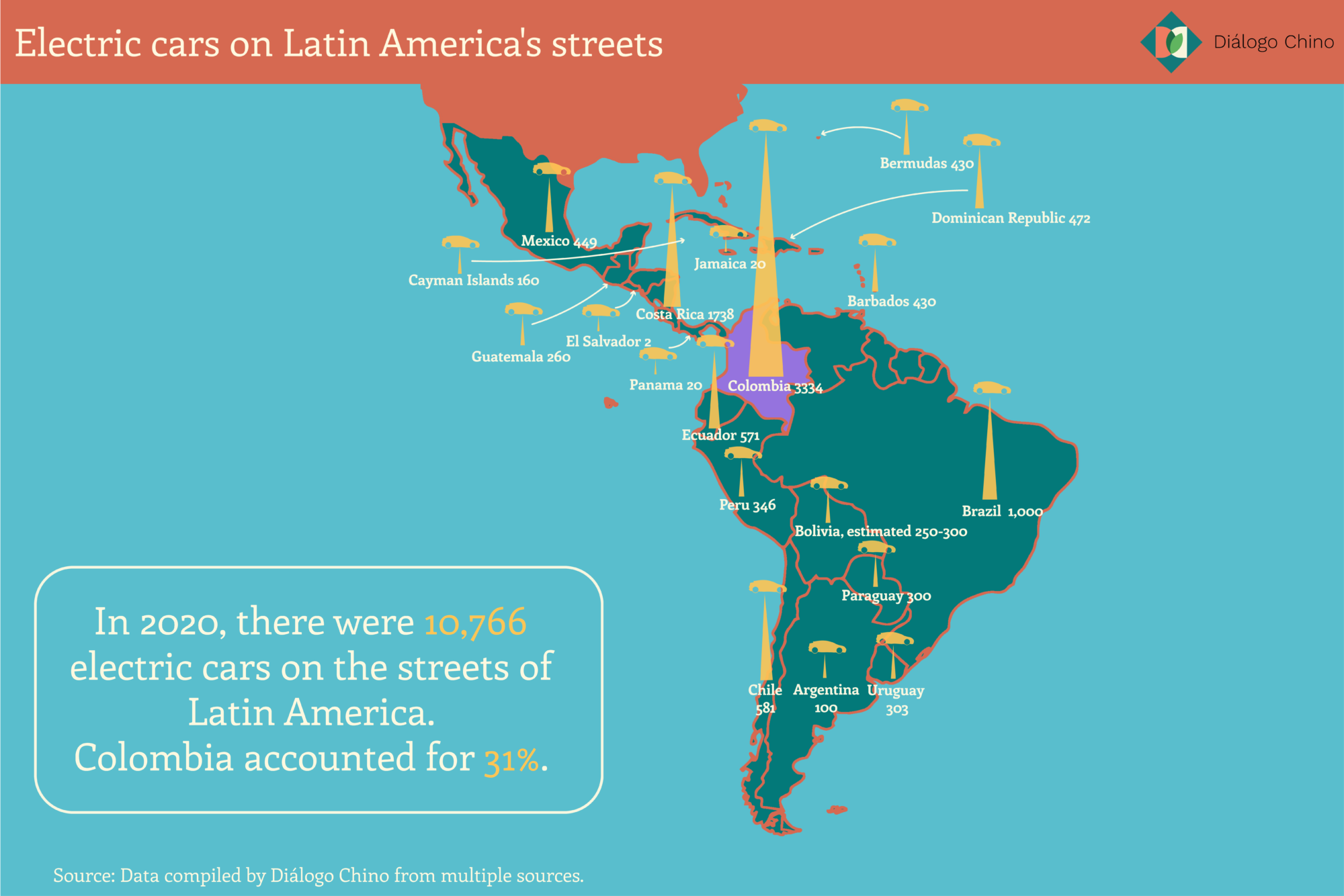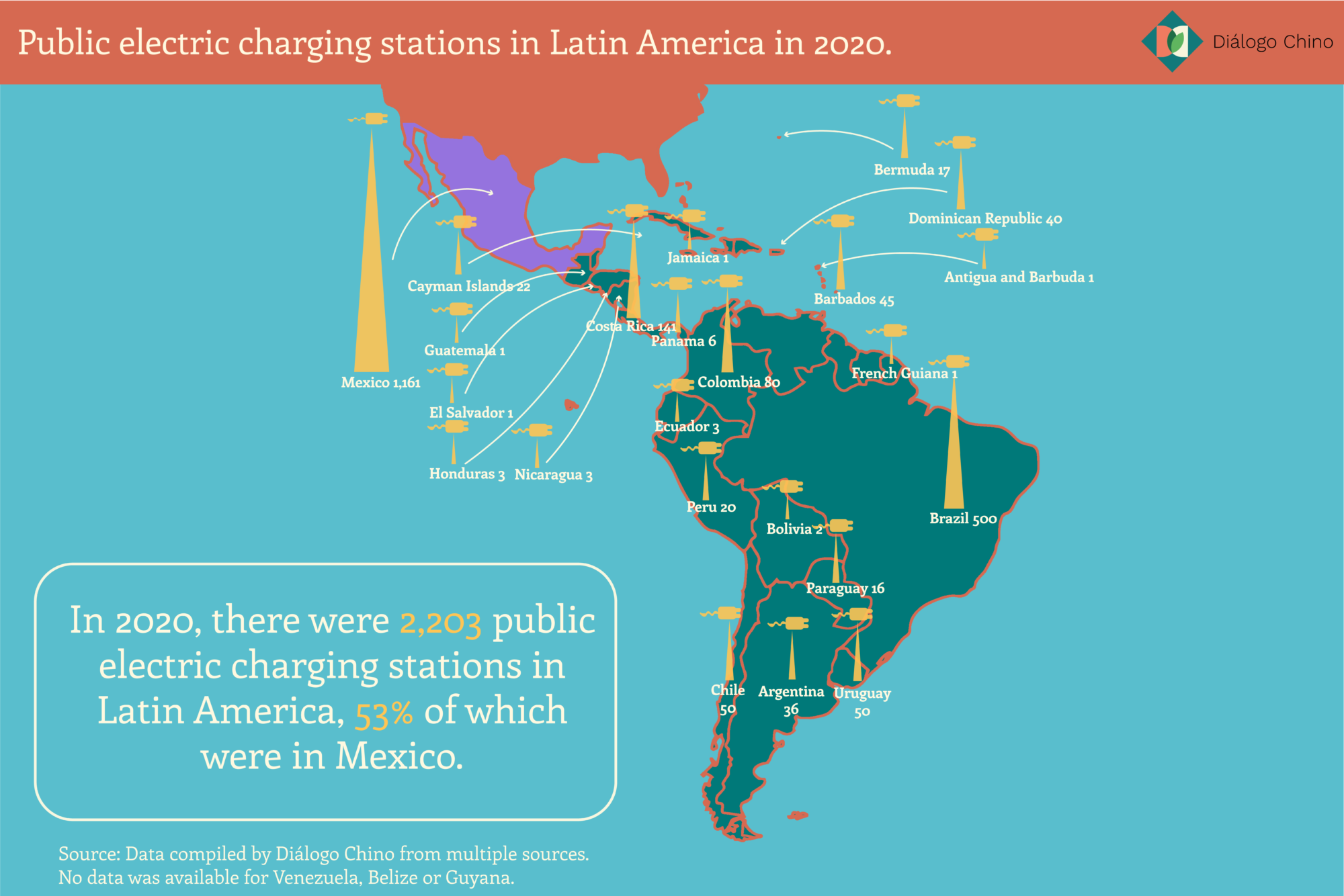Still at an early stage of adopting the technology, Latin American and Caribbean countries are gradually growing the number of privately-owned electric vehicles (EVs) on the streets. In 2020, there were 10,766, supported by a network of 1,292 public charging stations. The trend is expected to accelerate as governments transition towards cleaner transport.
The transport sector is the largest source of energy-related emissions in Latin America. The region’s car fleet is responsible for about 37% of these, while the rest corresponds to trucks and public transportation. Many cities have unsafe levels of air pollution.
Still, the region has a critical window of opportunity for electrifying its transport sector, experts say. Latin America has one of the cleanest electricity matrices in the world, with 60% installed capacity coming from renewables, higher than the global average. It also has the fastest growing car fleet in the world, which is expected to hit 200 million by 2050.
The Covid-19 pandemic has increased the use of private travel and car sales in most Latin American cities because of fears of infection on public transportation. Riding app Cabify saw a 400% increase in its usage in areas of Chile, while in Argentina car sales rose 105% last March, compared to the same month last year when the pandemic first struck.

Electric mobility policy is already moving fast in Latin America. Numerous countries have incentives for EVs, such as exemptions or discounts on sales, environmental, and import taxes, revenue-neutral “feebates” that tax polluting cars and reward clean ones and exemptions from traffic permits and restrictions.
“I definitely expect to see growth in electric car and bus markets, as well as two-wheelers in Latin America in the coming years. Some governments in the region have very good electric transport strategies but other countries need to strengthen their broad strategy as well as specific regulations,” said Lisa Viscidi, an energy specialist at the Inter-American Dialogue.
Many barriers remain. Upfront costs are hefty for developing countries, charging infrastructure is insufficient and most of government subsidies are still allocated to fossil fuels. Overcoming these obstacles will require developing electric mobility strategies, strengthening financial incentives and lowering costs, according to experts.
Here is a snapshot of the EV market in selected countries of the region.
Chile
Since 2016, Chile has had a National Electromobility Strategy, which includes the goal of electrifying 40% of the private fleet by 2050. The government expects its public, private, and commercial fleet of EVs to reach five million by midcentury. This would avoid the emission of 11 million tons of CO2 per year, according to government estimates.
There are already 581 electric cars in the country, all of which were imported. The country also has two main fast charging corridors. One is known as VOLTEX and is located in the Central-South zone, while the second one is located in the southern part of the country and is connected to the Argentinian province of Neuquen.
Franco Basso, an EVs researcher at Valparaiso Catholic University, highlighted the steps the government has taken so far but called for more charging stations and lower prices, which he describes as the main barriers. Most electric cars can be found in Chile’s largest cities, with the Hyundai Ioniq being the best-selling model.
Argentina
Argentina does not have national legislation for electric mobility. Yet, this could change this year as President Alberto Fernández has submitted a bill to Congress that includes overall fiscal benefits for EV purchases. With about 100 electric cars and very few electric buses, the country is lagging behind compared to neighbours Uruguay and Chile.
Electric cars are still luxury cars
Ricardo Berizzo, a specialist on electric vehicles, said the transition towards EVs will be more difficult for Argentina, Brazil and Mexico since they are the main vehicle producing countries in the region. These three should work together as their industries are connected through imports and exports.
Three electric cars are already manufactured in Argentina. They are: Sero Electric by Movi Electric; Tito by Coradir; and Volt by Volt Motors. Imported cars are also available, such as Renault’s Kangoo ZE, Nissan’s Leaf, BYD’s E5 and Audi’s E-Tron. Chinese manufacturer Chery recently said it could start producing EVs in Argentina.
Brazil
Despite having one of Latin America’s cleanest energy power grids, Brazil is lagging behind in the EV industry as the government stalls on existing policies, and there is a lack of coordination between researchers, the central and local governments, and manufacturers.
There were approximately 1,000 EVs on Brazil’s roads by December 2019, with 500 charging stations. Yet, these figures are considered way below Brazil’s potential. “Brazil is still living in the last century,” said Adalberto Maluf, president of the Brazilian Electric Vehicle Association (ABVE).
Brasília had two important policies that could have stimulated the EV market: Inova Energia (2013-2017); and Rota 2030, but business pressures left EVs behind. “Lobbying has derailed the version of Rota 2030 that was approved, throwing the energy efficiency plan into the trash,” Maluf said.
The lack of sectoral incentives to lower the costs of EVs is another bottleneck. With high excise taxes, EVs still cost up to 25% more for consumers compared to fossil fuel-based vehicles, according to ABVE.
Brazil is still focused on hybrid vehicles that are fueled by ethanol and electric batteries. This strategy, however, could leave the country even further behind since the US and Europe are already moving to the full electrification of transport and implementing low emission zones. “If Brazil begins to invest a lot in the hybrid vehicle now, it might be stuck with a stranded asset,” said Tatiana Bruce, a researcher in sustainable energy systems at the University of Lisbon.
Costa Rica
EVs have been gaining ground in Costa Rica for almost three years, driven by the 2018 Incentives and Promotion of Electric Transportation Law. It establishes fiscal and non-fiscal incentives to accelerate the transition to zero-emission vehicles and promotes the adoption of EVs and the infrastructure necessary to sustain them. In 2017 there were 147 electric cars, there were 340 in 2018 and 801 in 2019, the 2018-19 jump represented a 136% year-on-year increase.
The country also has a National Decarbonisation Plan that aims to modernise the vehicle fleet, both public and private, and promote electric transport. The plan includes a set of goals, such as achieving a 70% share of zero emissions buses and taxis by 2035 and 100% by 2050. It also aims to reduce freight transport’s emissions by 20% by 2050.
Mexico
Incentives are offered for private EVs at varying levels in different states. For example, electric, hybrid and hydrogen vehicle owners do not pay the federal new car tax (ISAN, by its Spanish acronym). These incentives have given the electric and hybrid vehicle market a boost. In 2018, Mexico reported 68% growth from the previous year in EV and hybrid vehicles sales, as they reached over 17,800. In 2019, electric and hybrid vehicles from January through September show a total of 955,393 units (although this figure consists almost entirely of hybrids).
In 2018, Mexico began developing its National Strategy for Electric Mobility, aiming to reach 50% hybrid or EVs by 2040, and 100% by 2050.
According to the Mexican Association of Automotive Industry (AMIA, by its Spanish acronym) Mexico has the most extensive charging infrastructure in the region, with more than 1,000 charging stations installed around the country. But for Rodrigo Diáz, Mexico City’s undersecretary of Mobility Planning, electric cars are still targeted towards a very small and wealthy sector of the population.

“Electric cars are still luxury cars. In Latin American cities that have huge budget problems, subsidising them does not make sense,” he Díaz.
Barbados
Barbados is an EVs leader in the Caribbean with around 430 on the road as of 2018. The government has taken some policy steps directed at expanding EVs. These include significantly lowering import duties and evaluating the transition away from dependence on fuel tax revenues.
Barbados is almost entirely reliant on oil imports for both power generation and transportation, but by 2023 the Barbadian government intends to achieve a 49% nationwide reduction in fossil fuel consumption, resulting in energy savings of US$200-400 million according to its 2019-2030 National Energy Policy. The government also aims to hit 100% reliance on renewable energy and carbon neutrality by 2030. As part of this plan, it is looking to deploy an entirely electric electric bus and government fleet by 2030.
Dominican Republic
From 2018 to January 2020 the number of electric cars on the road increased from 55 to around 472. Currently, the Dominican Republic has the greatest number of alternatives for buying EVs in the Caribbean, according to a study entitled Electrified Islands: The Road to E-mobility in the Caribbean.
There is a 50% reduction in duties and registration fees for EVs. The executive director of the National Energy Commission (CNE) said that the government will introduce incentives related to import costs, charging services, and electricity tariffs, and that it hopes the country will see large-scale EV deployment in the near future.
However, the government’s involvement in EV deployment has been limited compared to other Caribbean countries. By one estimate, there are just 40 public charging stations in the country of 10.6 million people. Yet by the end of 2021, the Consorcio Eléctrico Punta Cana Macao (CEPM), a subsidiary of InterEnergy, plans to install 500 chargers (mostly level 2) across the country in a joint venture with Blink Charging, a US provider of EV charging station services.
Cayman Islands
The government has begun implementing measures to facilitate EVs in the self-governing British Island. In 2019, it eliminated duties on imported EVs for personal use valued under US$30,000 (for ICEVs in this price range, duties range from 29.5% to 37%).
In its 2017-2037 National Energy Policy, the government established the goal to “increase the share of fuel efficient, electric, and hybrid vehicles in the Cayman Islands fleet” and reach a dependence on renewable energy of 70% by 2037 (currently it is at 3%). Increasing EV use is a central component and the plan’s transport sector strategy, which aims to slash gasoline and diesel consumption by the transport sector by 68% by 2037, based on 2015 levels.
Peru
In August 2020, the Ministry of Energy approved provisions to implement the future charging and energy supply infrastructure for electric mobility. In other words, anyone who wishes to install charging points in their homes, workplaces or private car parks will be able to do so. A year earlier, the ministry declared the promotion of electric and hybrid cars to be of national interest and exempted them from paying the selective consumption tax.
Although the market for eco-friendly cars is not large compared to other countries in the region, 2020 was a year of historic high sales of 552 hybrids and 26 electric cars. The goal for 2030 is to have 5% of all cars and buses using electric energy. “The EV sector in the country is still not moving much. Where we are seeing a great opportunity is in the mining sector, where we are introducing our electric trucks for material transport,” said José Luis Torres, Sales Manager of BYD Peru.

Bolivia
On his first day in office as mayor of La Paz, Iván Arias arrived in an electric car. This marked a milestone in the country and showed that there are some in government open to this type of mobility. The car Arias drove was a 100% electric Quantum, made in the Bolivian city of Cochabamba, where these vehicles have tax discounts.
“We are a Bolivian company with a presence in the region, where we want to continue expanding. We are in Bolivia, Peru, Paraguay and El Salvador, and we want to enter the Mexican market soon,” said Carlos Soruco, director and founder of Quantum, which has a project to produce batteries with Bolivian lithium.
Colombia
On the last day of 2020, the Ministry of Finance published a decree exempting the import of EVs from import duties until 2022. Since 2018, Colombia has developed a regulatory framework to promote the transition to EVs, with various laws that reduce taxes and eliminate restrictions on transit, as is the case for conventional cars.
The country’s main goal is to reach 600,000 electric vehicles on Colombian roads by 2030. In 2020 alone, 1,321 vehicles were sold. Marco Pastrana, divisional manager for Chinese manufacturer BYD and the Japanese Mitsubishi, said: “Colombia is the country that sells the most electric vehicles in Latin America.”
Ecuador
The first quarter of this year has seen 19 electric cars sold nationwide, according to the Association of Automotive Companies of Ecuador (Aeade). As sales are dip in the midst of the pandemic, it’s difficult to see 2021 surpassing the 106 units sold last year.
Similarly, the automotive sector is waiting for the government to speed up the enactment of projects that encourage the use of these vehicles. A regulation of the Energy Efficiency Law, as well as the Electric Mobility Law, are halfway towards entering into force.








